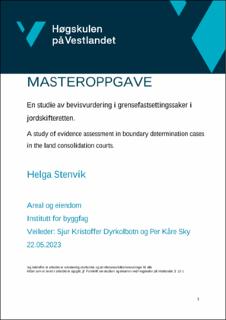En studie av bevisvurdering i grensefastsettingssaker i jordskifteretten
Master thesis

Permanent lenke
https://hdl.handle.net/11250/3073329Utgivelsesdato
2023Metadata
Vis full innførselSamlinger
- Institutt for byggfag [273]
Sammendrag
I denne masteroppgaven har jeg gjort en undersøkelse av hvordan jordskifteretten vurderer bevis i grensefastsettingssaker. For å undersøke dette er det blitt gjort en kvantitativ og kvalitativ analyse av 100 rettsavgjørelser fra jordskifterettene.
Hovedproblemstillingen for oppgaven er:
Hvordan vurderer jordskifteretten bevis i grensefastsettingssaker?
For å besvare hovedproblemstillingen er det utarbeid 3 delproblemstillinger:
1) Hvilke typer bevis blir ført av partene i grensefastsettingssaker?
2) Hvilken vekt legger jordskifteretten på de ulike bevisene i sakene?
3) Hvordan står partenes totale bevisvekt, resultat og avgjørelse om sakskostnader i forhold til hverandre?
Delproblemstilling 1 belyser hvilke typer av bevis som er mest fremtredende i jordskifteretten, og hvilket bevisgrunnlag jordskifteretten har til å basere avgjørelsen sin på i sakene.
I delproblemstilling 2 er det forsøkt å kategorisere hvordan jordskifteretten vekter ulike typer bevis. Ettersom prinsippet om fri bevisvurdering gjelder, varierer jordskifterettens vekting bevisene fra sak til sak. Resultatene viser at det er mange fremlagte bevismidler som retten vurderer til å ha ingen betydning for avgjørelsen. Samtidig viser resultatene at det er noen bevismidler som stort sett får høy eller avgjørende vekt dersom de er relevante for å fastsette grensen. Hvordan retten vekter andre bevismidler enn stiftelsesdokumenter og grensemerker avhenger i stor grad av kvalitet på stiftelsesdokumentene.
Resultatene fra delproblemstilling 3 viser at i 86 % av sakene er det parten som har høyest samlet bevisvekt som vinner saken, eller at partene har lik samlet bevisvekt og begge får delvis medhold i saken. Dette indikerer at kodingen av rettens vurdering av bevisene i stor grad har stemt overens med de faktiske resultatene i saken. Samtidig viser funnene at i en del av sakene hvor prediksjonen ikke samsvarer med resultatet, har retten vært i tvil om avgjørelsen og gjort unntak fra hovedregelen om erstatning av sakskostnader direkte knyttet til tvisten. In this master's thesis, I have conducted a study on how the land consolidation court evaluates evidence in boundary determination cases. To investigate this, a quantitative and qualitative analysis of 100 court decisions from the land consolidation courts has been conducted.
The main research question for the thesis is:
How does the land consolidation court evaluate evidence in boundary determination cases?
To answer the main research question, three sub-questions have been formulated:
1) What types of evidence are presented by the parties in boundary determination cases?
2) How does the land consolidation court weigh the different types of evidence in the cases?
3) How do the parties' total evidence weight, outcome, and decision on litigation costs relate to each other?
Sub-question 1 shows which types of evidence that are most prominent in the land consolidation court and the evidentiary basis on which the court relies in making its decisions in the cases.
In sub-question 2, there has been an attempt to categorize how the land consolidation court weighs different types of evidence. Since the principle of free evaluation of evidence applies, the court's weighting of evidence varies from case to case. The results show that there is a lot of evidence presented that are by the land consolidation court considered to be of no significance to the decision. At the same time, the results indicate that certain pieces of evidence generally carry high or decisive weight if they are relevant for determining the boundary. How the court weighs other pieces of evidence besides founding documents and boundary markers largely depends on the quality of the founding documents.
The results from sub-question 3 reveal that in 86% of the cases, the party with the highest total evidence weight wins the case, or both parties have an equal total evidence weight, and both receive partial support in the case. This indicates that the coding of the court's evaluation of evidence largely corresponds to the actual outcomes in the cases. At the same time, the findings also show that in some cases where the prediction does not match the outcome, the court has expressed doubt in its decision and deviated from the main rule regarding the compensation for legal costs directly related to the dispute.
Beskrivelse
Masteroppgave i areal og eiendom.
Fakultet for ingeniør- og naturvitskap/ Institutt for byggfag/ Høgskulen på Vestlandet, campus Bergen.
